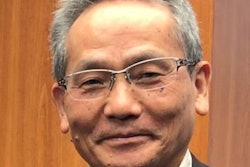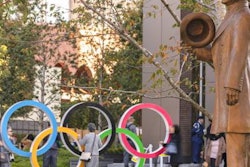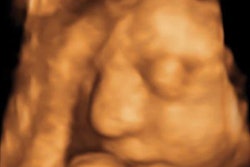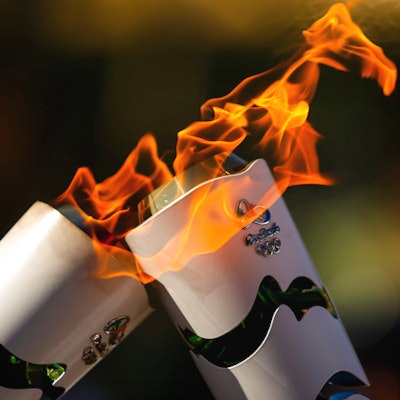
The Rio Olympics begin on Friday. An impressive range of imaging equipment will be housed in the 3,500-sq-m polyclinic, which will stay open until the Paralympics ends on 18 September.
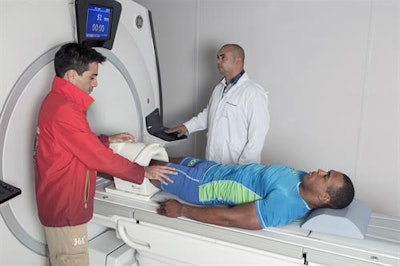 Dr. Marcelo Patricio (left), deputy chief medical officer for Rio 2016, oversees an MRI examination being performed on the Brazilian canoe sprint athlete Edson Freitas da Silva. He is assisted by Wallace do Amaral, a clinical application specialist from GE Healthcare. All photos courtesy of GE Healthcare.
Dr. Marcelo Patricio (left), deputy chief medical officer for Rio 2016, oversees an MRI examination being performed on the Brazilian canoe sprint athlete Edson Freitas da Silva. He is assisted by Wallace do Amaral, a clinical application specialist from GE Healthcare. All photos courtesy of GE Healthcare.As was the case at London 2012, GE Healthcare has provided the equipment for Rio 2016. It has installed the following in the polyclinic: two MRI systems (1.5-tesla Optima MR 450w and 3-tesla Discovery MR 750w); four ultrasound machines (Logiq E9 ultrasound with XD Clear, Logiq E, Logiq E R7, Vscan dual); three x-ray units (Discovery XR 656); and a PACS, RIS, and Centricity Practice Solution electronic medical record (EMR) system.
A CT scanner was available at London 2012 to guide interventional procedures, but has been dispensed with for Rio 2016.
"This is the first time that the polyclinic of the Olympic and Paralympic Games will use the Centricity Practice Solution," noted Daurio Speranzini Jr., president and CEO for Latin America at GE Healthcare, based in São Paulo. "The EMR technology allows access to workflows and provides data combination for smarter and more precise diagnosis at any time. The medical records will be accessible at any of the multiple medical posts throughout the games."
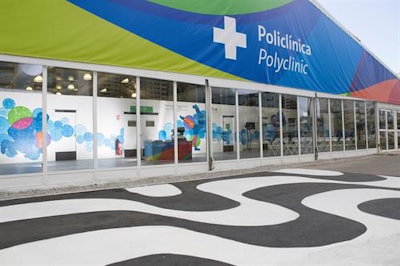 The 3,500-sq-m polyclinic has extensive imaging, dental, ophthalmology, pharmacy, and clinical therapy facilities.
The 3,500-sq-m polyclinic has extensive imaging, dental, ophthalmology, pharmacy, and clinical therapy facilities.The equipment was developed initially for the U.S. Olympic Committee (USOC), and has been used successfully since the London 2012 games. It is more than an EMR because it enables unifying all attending information in the same cloud platform, as well as performing analysis, making an evolving, feasible assessment of the athletes' physical conditions, he continued. Also, it can be used for future editions of the games.
Based on feedback received from those who have already used this platform, among the advantages are the quality of the information, the quick analysis and responses, and the possibility of managing the athletes' health and avoiding unnecessary procedures. The RIS and PACS will also be implemented in the polyclinic, with the purpose of managing the traffic of reports and imaging exams made onsite, assuring more precise diagnosis, Speranzini said. These solutions have also been used for the London 2012 and the Sochi 2014 Games.
 Priscilla Souza, a clinical application specialist from GE Healthcare, tests the ultrasound equipment on Edson Freitas Da Silva.
Priscilla Souza, a clinical application specialist from GE Healthcare, tests the ultrasound equipment on Edson Freitas Da Silva."I think the EMR is a big step forward for the games," said Dr. João Grangeiro, chief medical officer of the Organizing Committee for the Olympic and Paralympic Games. "In the past, we relied on patchy records and the medical encounters we already had with the athletes. Now, we have the chance to have all their previous imaging data and records on the same digital file and in a cloud system that we can access anywhere; the way we manage patients is going to be much more efficient."
Around 40 engineers and clinical application specialists from GE will work during Rio 2016 to support the team of volunteers that is working in the diagnostic area 24 hours per day in the polyclinic and other emergency areas. The company has also provided training sessions for the volunteers to explain how to use the equipment.
Boost for healthcare
The games will give a much-needed boost to Brazil's healthcare system, Grangeiro emphasized. The polyclinic itself is not a permanent construction, but other gifts will benefit patients for many years to come.
After Rio 2016, new medical devices worth more than 1.8 million euros will be donated to Souza Aguiar Hospital, including four robotic surgical arms, six surgery monitors, six anesthetic machines, three digital x-ray systems, three ultrasound units, and software to securely store and manage patients' scans.
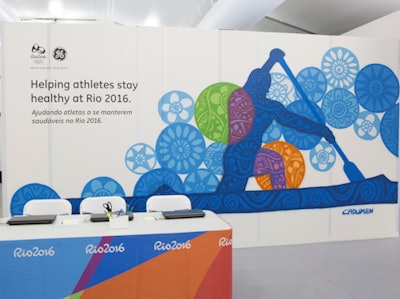 Ready for business: The reception desk at the polyclinic.
Ready for business: The reception desk at the polyclinic.The hospital lies in the heart of Rio, and it is Latin America's second-largest emergency care center and the city's busiest trauma hospital. It has more than 600 beds and sees in excess of 7,500 patients each month.
Grangeiro is overseeing the polyclinic, which also has dental, ophthalmology, pharmacy, and clinical therapy facilities. He will be in charge of doctors from many different specialties, from sports medicine and radiology to physiotherapy and dermatology.
About 5,000 volunteers will assist medical professionals, technical committees, and the general public at the 112 health centers scattered across the city to add to the service on offer at the four public hospitals. The medical team is very experienced, coming mostly from Brazil, and all of them were carefully chosen, meeting the Olympics' health requirements. To work in this area, volunteers must have graduated or qualified in their profession by January 2016.
The Olympic Village has 10,160 rooms, 18,000 beds, seven laundries, and a massive gym. The main dining area in the village consists of a sprawling tent, where officials expect to serve about 60,000 meals daily to Olympians and staff, and perhaps another 10,000 daily to the volunteers.
Safe sex
The organizers are providing 450,000 condoms (three times more than London did four years ago), including 100,000 female condoms, according to an article posted on 23 July by StarTribune.com. The aim is to encourage safe sex. Many had considered that the increased supply of condoms was due to the threat posed by the Zika virus, but when he was asked about it, Deputy Chief Medical Officer Dr. Marcelo Patricio insisted this is not the case.
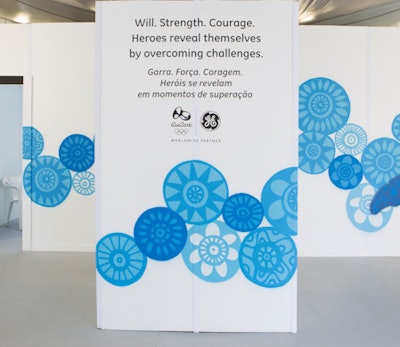 "Will. Strength. Courage." is the message that will greet athletes when they enter the polyclinic.
"Will. Strength. Courage." is the message that will greet athletes when they enter the polyclinic.There is a very low or no risk of visitors catching the Zika virus in Rio this year, the organizers have insisted. Travel to Rio during the games will represent less than 1% of all travel to Zika-infected areas, so if the games were not to happen or if they were postponed, 99% of the risk of Zika would continue to spread across the world because of general international travel, they stated. For every 1 million tourists, an average of 1.8 people will be affected, which is equal to one case of Zika out of the 500,000 visitors expected to be in the city during the games.
As for the spread of Zika via sexual contact, it is important to clarify that it is already a policy of the International Olympic Committee at every edition of the games to act in conjunction with health authorities to prevent the spread of sexually transmitted infections, and this concern has existed long before Zika, the organizers noted.




